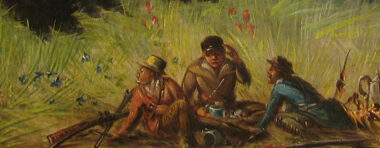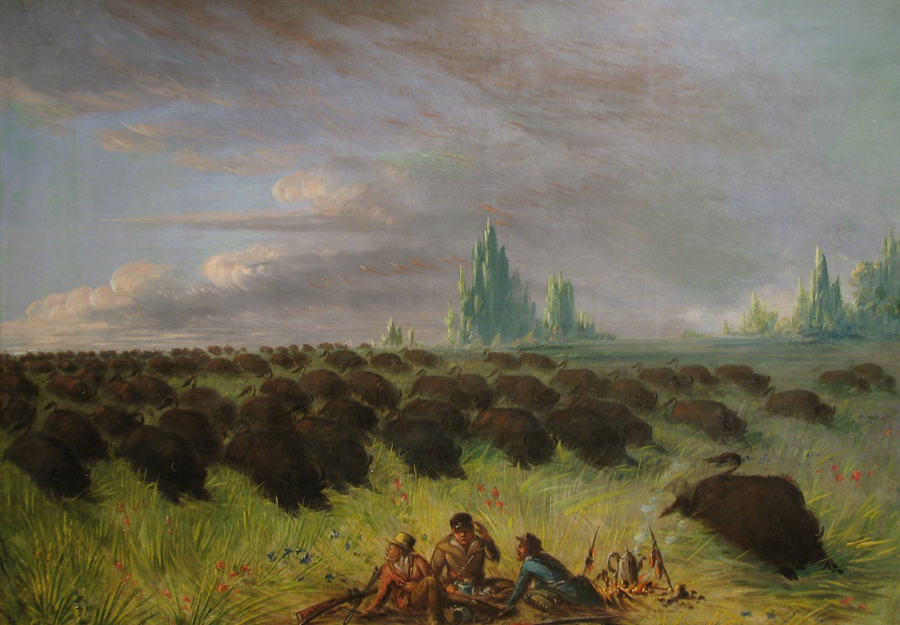When Charles Dickens visited the Looking Glass Prairie in 1842, it reminded him of a Catlin exhibition in London. “The sun was going down, very red and bright,” Dickens writes, “and the prospect looked like that ruddy sketch of Catlin’s, which attracted our attention (you remember?) except that there was not so much ground as he represents, between the spectator and the horizon.”
Dickens did not know that sometime about 1834-35, Catlin had picnicked on the Prairie in Alton, Illinois, about forty miles north of the Looking Glass Prairie. At the time, Catlin was on a painting trip traveling across the plains towards St. Louis, his home base. Traveling was arduous, and a picnic lunch was a rare moment of leisure on a five-hundred-mile trek. Catlin’s Letters And Notes, published in 1842 when Dickens was touring the Eastern United States, including a description of what might be the source for A Prairie Picnic Disturbed by a Rushing Herd of Buffalo: “On the night of this memorable day, Charley and I stopped in one of the most lovely little valleys I ever saw, and even far more beautiful than could have been imagined by mortal man. An enchanting little lawn of five or six acres, on the banks of a cool and rippling stream, that was alive with fish; and every now and then a fine brood of young ducks, just old enough for delicious food, and too unsophisticated to avoid an easy and simple death. This little lawn was surrounded by bunches and copses of the most luxuriant and picturesque foliage, consisting of the lofty bois d’arcs and elms, spreading out their huge branches, as if offering protection to the rounded groups of cherry and plum trees that supported festoons of rape-vines, with their purple clusters that hung in the most tempting manner over the green carpet that was everywhere decked out with wildflowers, of all tints and of various sizes, from the modest wild sunflowers, with their thousand tall and drooping heads, to the lilies that stood, and the violets that crept beneath them. By the side of this cool stream, Charley was fastened near him my bearskin was spread in the grass, and by it my little fire, to which I soon brought a fine string of perch from the brook; from which, and a broiled duck, and a delicious cup of coffee, I made my dinner and supper, which were usually united in one meal, at half an hour’s sun. After this I strolled about this sweet little paradise, which I found was chosen, not only by myself, but by the wild deer, which were repeatedly rising from their quiet lairs, and bounding out, and over the graceful swells of the prairies which hemmed in and framed this little picture of sweetest tints and most masterly touches.”
Catlin added the charging buffalo herb to provide local color and drama. What he once described as a paradise in 1834 in the 1854 painting becomes humorous. Instead of being alone, Catlin sits with two companions while a herd of stampeding buffalo is about to overrun the campsite. The men are anxious, but Catlin, wearing a hunter’s cap, is unperturbed. He’s calmly sitting by the fire, enjoying the moment. It’s an impossible situation to escape alive. How Catlin’s viewers regard it is unknown. I’ve not seen any literature on the subject.
See George Catlin. Letters And Notes On The Manners, Customs, And Conditions Of North American Indians (New York: 1842). [Published in London 1841] http://archive.org/stream/americanindnorth02catlrich/americanindnorth02catlrich_djvu.txt; A Prairie Picnic Disturbed by a Rushing Herd of Buffalo (1854), oil on canvas, 18 ¾ x 26 ½ in.; 47.63 x 67.31 cm; Gift of Mr. Carman H. Messmore, 1966.624; http://www.joslyn.org/collections-and-exhibitions/permanent-collections/art-of-the-american-west/george-catlin-a-prairie-picnic-disturbed-by-a-rushing-herd-of-buffalo/ ; http://user.xmission.com/~drudy/mtman/html/catlin/; http://catalog.hathitrust.org/Record/010327624 Dickens. “A Jaunt to the Looking Glass Prairie and Back.” In American Notes for General Circulation. London, 1842. http://www.gutenberg.org/files/675/675-h/675-h.htm ; http://books.google.com/books?id=WQolAAAAMAAJ&printsec=frontcover&dq=dickens+american+notes+1842+vol+2&hl=en&sa=X&ei=hNldUe6zPM7h4APy0ICoAQ&ved=0CDEQ6AEwAA#v=onepage&q=looking-glass%20prairie&f=false ; Charles Dickens. Letters of Charles Dickens 1842-1843. Edited by Graham Storey and Kathleen Tillotson. Oxford: Oxford University Press, 1974.

